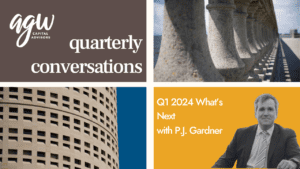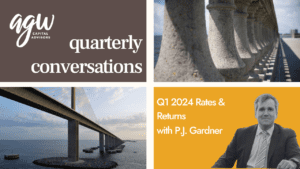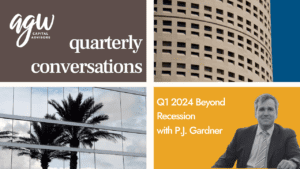Quarterly Conversations – Debt Ceiling, Inflation & Recession
AGW Capital Advisors begins a new content series this year to bring you insights and perspective on activities and trends in capital markets domestically and abroad. This is the first episode in the series, and we’ll evolve the content and format over the next several quarters. We hope you enjoy it, and we’d love to hear from you on how we can make it more informative.
In this installment, Principal & Co-Founder P.J. Gardner, CFA®, CFP®, CIMA®, shares an honest breakdown of June’s debt ceiling increase, inflation, recession, and investing in times of uncertainty. This conversation was recorded on June 6, 2023, and all information reflects information available at that time.
Audio Only
Highlights
DEBT CEILING
- The U.S. government has once again extended or increased the debt ceiling, marking the 78th time since 1960. This decision was bipartisan, indicating the potential for cooperation on major issues.
- The U.S. debt to GDP ratio is now at levels similar to those seen after World War II, despite the country not being in a major war. This has been largely self-created through financial decisions.
- Some economists, such as modern monetary theorists, believe that the debt-to-GDP ratio does not matter. Countries like Japan, China, and Singapore have higher debt-to-GDP ratios than the U.S. without significant issues.
- The idea of the U.S. ever defaulting on its debt is seen as unlikely due to the potential catastrophic effects on the global financial system. The options to address the debt include growing the economy, cutting spending, or allowing inflation to occur.
INFLATION
- The U.S. has experienced periods of inflation in its history, and it’s important to consider what era of inflation we might be entering now.
- Despite the economic growth the Baby Boom Generation brought, the U.S. still had to inflate its way out of debt. This suggests that inflation may be the most likely path out of the current debt situation.
- Investors should think probabilistically rather than in absolutes, considering the likelihood of inflation returning to the Federal Reserve’s 2% target. Factors such as the reshoring of manufacturing and a tight labor force could keep inflation elevated.
- The Federal Reserve’s actions, such as raising interest rates, indicate a different approach to managing inflation compared to past crises.
RECESSION
- The Federal Reserve seems intent on controlling inflation, even if it means pushing the economy into a recession. Unemployment is currently at 50-year lows, indicating a shortage of labor.
- Structural forces such as reshoring and labor shortages could continue to put upward pressure on inflation. This could lead to a recession, although the exact timing is uncertain.
- Investments in energy, material, and mining companies could provide a hedge against inflation. These companies can make money in any environment but will benefit more if commodity prices rise.
UNCERTAINTY
- The current economic environment is uncertain and requires more sophisticated investment strategies than simply being long on stocks and bonds.
- Asset classes such as energy, material, and mining companies, as well as investments that move with inflation, can provide stability in uncertain times.
- The key to investing in this environment is to think outside the box and consider other asset classes that can provide returns even when stocks and bonds perform poorly.
PERSPECTIVE
- The likelihood of a recession is high, although the exact timing is uncertain. The Federal Reserve seems intent on controlling inflation, even if it means pushing the economy into a recession.
- The Federal Reserve has increased interest rates quickly and dramatically, which could slow the economy. The effects of these rate hikes may not be felt immediately due to the lag in monetary policy.
- The Federal Reserve’s actions suggest that they are prepared for a recession and are doing everything possible to bring it about. This includes raising interest rates and laying off workers.
- The current economic environment differs from the past, with higher interest rates and a more expensive market. This could lead to a market correction and a potential recession.
Full Transcript
DEBT CEILING
Okay, so starting with the debt ceiling, this is one of the more anti-climactic things that we see. This is like the 78th time since 1960 that they’ve extended or increased the debt ceiling. And so once again, they decided to do that.
The fact that they did that’s not that surprising had they kicked into a prioritization of payments, which could have been an interesting sort of new step. I think their constituents would very quickly and loudly vocalize their opposition against their position, and it would have quickly resolved itself. It is quite remarkable that it was bipartisan and truly bipartisan. And so I think that gives some hope, that on major issues, some things might get done.
But I think the larger issue if you sort of zoom out, and you and you say, Well, this is so weird, right? So why does our government pass a budget and then later decide whether or not to increase the debt limit such that they can fund it? I think you got to ask, what’s the debt ceiling? What’s a reasonable debt ceiling to have. And we are pushing the limits of what has historically been in the US.
So if you look at US debt to GDP, now, it’s about the same level as it was in the aftermath of World War II. We haven’t been in a war. We’ve been in some financial skirmishes of sorts. But we’ve largely created this on our own. So where do we go from here?
Some people and this would include the modern monetary theorist, believe that debt to GDP doesn’t matter. And I would tell you that one of the biggest Widowmaker trades out there was to short Japanese yen. And if you look at debt to GDP, in China, or in Japan, or Singapore, they’re much higher than even in the US. So it’s possible that we could go on in this current trajectory and not have a significant issue. It seems like all roads ultimately lead to inflation. And that’s, in fact, what we are experiencing now.
The idea that the US would default on its debt is ridiculous. It would be catastrophic to the global financial system. So you can, if you think about what are the different ways out of it, you can default, you could grow your way out of it. And if you think about the last time we were at these levels, interestingly, leading economists at the time thought that the global economy was on the verge of collapse. Why? Because it was all engineered around the war effort. And so, what would happen without a war?
Well, the GIs came home, got educated, moved out to the suburbs, had kids, and increased the productivity level of the United States. And that’s the biggest growth engine in the history of modern economics and finance.
So growth can be underestimated. But it’s hard to see that now, especially with the population rate, outside of the Latino communities, sort of falling. So it’s hard to see the path to really do that. The other catalyst for growth tends to be R&D, and finally. And, finally, we did get some things [legislation] passed around infrastructure. But it’s hard to point to the US growing above a, call it, 2% GDP growth.
So another way you could do it is to cut your way out. So you could cut spending. I think if there are two things both parties seem to be agreed upon, it’s we are going to raise the deficit either way, whether that’s cutting taxes, if you’re a Republican or increasing spending if you’re a Democrat. So I’d say that that has little to no chance of happening.
Then that leaves the fourth option, which is inflation, which is kind of a nice thing in that you don’t have to pass a bill. You don’t have to do anything. But it certainly is a tax. It’s a tax on the saver, right? So if you just keep your money in cash, inflation will outstrip it; or the bondholder, they’re the ones that ultimately paid for it.
And finally, you know, you shut down the economy, you pass legislation, it floods the system with money, including paying people not to work, and what do you get? You get inflation. So it looks like for the first time in a long time, the finance and economic textbooks that we all grew up reading are right once again, in the notion of modern monetary theory, these other concepts leave a lot to be desired or are certainly in their infancy in terms of proving their worthiness.
I think that the discussion that should be had that needs to be had, which started, if you think about it, back when Obama took office, and you had to urge Erskine Bowles, that were out talking about the consequences of this and the need to act sooner rather than later. That, to me, is the discussion. Where are we realistically going? If you look at the CBO projections, they don’t have priced in a recession, which looks to be inevitable, or even necessary, in order to get inflation under control. So that’s to say, I think debt to GDP levels are going to even overshoot what a lot of people are projecting.
And so we are going to test those limits. And when that exact point occurs, nobody knows. But I think you got to be prepared and vigilant for it.
INFLATION
So to the degree that the past is prologue and you get back to World War II and say what happened after that? We did grow, right? But yet, that wasn’t enough. And in 1968, we got off the gold standard. And that really unleashes inflation. And so when you look at sort of the eras of inflation that we’ve had in our history, I think a good question is what era might be entering.
If you look sort of post World War II, you had a steady climb in inflation, interested in winning the Federal Reserve in the 70s; when you think about what the Federal Reserve is trying to do today, the Federal Reserve, at that time, staff were very smart, competent people tried and failed two times, to squelch inflation. Only to then have it really blow off the top and approach, I think, 16% and have Paul Volcker come in, raise the Fed funds rate to 21%, which nobody’s even in the realm of thinking about to push the economy in a recession. To drive unemployment up. And to get inflation back under control. And that worked in three years, in 1983, he it down to roughly 3%.
So even with the Baby Boom Generation, which is an incredible economic growth engine, you still had to inflate your way out of it. And remember, along the way, they tried all different kinds of things in terms of tax, taxing, changing tax brackets, and so forth. So to me, there really only seems one logical path out and that’s inflation.
We, after having that, that episode of, you know, very high inflation in the 70s. We’ve entered ever since then, this period of sort of Goldilocks, not too hot, not too cold inflation. And I think everybody’s grown accustomed to that. And so, you know, you’re seeing inflation at its highest levels in 40 years, and you’re seeing interest rates at their highest levels in 14 years. And I think as a smart investor, you can’t just say, you can’t think in absolutes like inflation absolutely will come down to the growth target at 2%. Or interest rates are going to go back down or, let’s say go back down to being anchored at zero, or maybe they’ll normalize at 5% on the short end and have kind of a typical yield curve structure.
Anytime you go all in on a certain strategy, invariably, it doesn’t work out for reasons that you can’t even begin to even comprehend. And those are only known in hindsight. So I would encourage investors in this environment of incredible uncertainty, uncertainty on a level that we haven’t seen, arguably in four decades, that you have to think probabilistically instead of in absolutes. And it’s about saying the likelihood that we get inflation, let’s say back down to the 2% target that the Fed is discussed over and over again, may not happen.
Why? Well, for decades, we’ve been offshoring manufacturing. Some estimates project that, or some estimates have calculated, but that’s taken about six-tenths of a percent off a CPI. So logically, as we onshore reassure, nearshore, whatever you would call it, one would expect the reverse to happen, maybe not completely in the other direction, because it looks like we’re still going to be offshore in some aspects of it. But as we nearshore or re-shore some of it you would expect that to happen.
The other thing is, the labor force is obviously incredibly tight, right? So think about this. The Federal Reserve has gone from zero to five and a quarter despite we had a huge banking crisis. I would have, I would say, the Federal Reserve’s of yesteryear, maybe going back to, let’s say, Greenspan would have used their blunt instruments very quickly think interest rates money supply to have saved that situation. Instead, they ringfence the issue, and they continue to raise rates.
That’s a radically different approach than the Fed has done. Really, I think, going back to the Mexican peso crisis, the Asian financial crisis. I think this is a different Fed. Or, perhaps, just a more learned fed, having seen prior policy decisions and effects.
RECESSION
You’ve got a Federal Reserve that seems very intent on squelching inflation at all cost. And yet, unemployment still sits at 50-year lows. So what does that tell you? Pretty obviously, we’ve got a shortage of labor, a big shortage of labor.
So nearshoring re-shoring keeps an elevation on inflation. A shortage of labor keeps an elevated upward pressure, let’s say, on wages. And yes, some of that can be managed with automation and AI, and machine learning. But at this point, you still need human beings and bodies. And they’re in short supply.
The other thing I’d tell you, which has been a fascinating evolution, when you go back, pre global financial crisis, and you think about what was going on in the boardroom, of any sort of business in the commodity complex, whether they were in energy, or copper, or whatever; there was very little money left in the cigar box. And what I mean by that is, they were making money, the money was going in the cigar box, and they were immediately going out and buying another mine or more rights to more commodity production. Or they’re acquiring other businesses, they were continuing sort of rollup in economies of scale, was, was to be helpful. That shifted and all of a sudden, you know, with the combination of I’ll say, the shift towards ESG and just the ship in the boardroom.
These companies that used to take all the money they would make and then go reinvest it started paying out dividends. And so I think an easy argument to make is that the whole commodity complex is under-supplied. And yes, maybe maybe, we’re going to be able to make continued progress with some of the other alternative energy sources. But for now, again, it looks like, we’re still going to be using a lot of what we’ve always used.
So for a whole variety of reasons, you’ve got structural forces that seem like they’re going to continue to put upward pressure on inflation. And so again, I think, whether that means we’re going to hit 2%, or whether that means we’ll level out at three, or maybe even four. Nobody knows with great precision. But you’ve got to invest for that possibility to unfold. Because it’s incredibly possible. How likely that’s for us to figure out what our clients, right? And then you got to size that accordingly. And you have to really think through, do I want to be in a binary trade? Where if inflation doesn’t happen, I lose. Or do you want to try to indirectly invest in a way that’s going to pick up should inflation persist at higher levels?
For example, you could buy a barrel of oil. And certainly, if you did that, in the 1970s, depending on when you did it, you might have gotten a good initial pop. But then, for decades, oil did nothing but go down into the first Gulf War. So meanwhile, Exxon, Chevron, we’re bringing out huge profits. So I like the idea of investing in energy material and mining companies. And there are some great managers that we work with and use with our clients that are identifying the types of companies to invest in that certainly are long levered to the commodity. So if the spot price of oil goes up, by all means, these companies are going to make yet more money, but they’re gonna figure out how to make money in any environment.
So we like investments like that. Certainly, maybe having a sliver of commodities or a sliver of gold might make sense. But the core of that, what I’ll call real return or inflation sensitive component of the portfolio, I think you want to be able to work kind of regardless of the market, but have kind of an upside optionality in the event inflation persisted to a higher level or spikes like it did multiple times during the 70s.
UNCERTAINTY
I think the key question then comes down to; how do you invest in an environment that is so uncertain that does have these economic variables that are unique, but yet we’ve seen before? And for the last, you could really say, four decades. If you were just long stocks and long bonds, you did great. Right?
Interest rates were 16%, call it on the 10-year treasury, and got down to one point, about 60 basis points, maybe even less. So that was a heck of a trend, right? As interest rates fell. Think about what someone would have paid for a double-digit, yielding treasury bond a lot. So you didn’t have to be that thoughtful or sophisticated about how you invest it, you just need to be long these two blunt instruments called stocks and bonds.
I think what we’re in today is a different environment that requires more thought, and more sophistication because the range of economic outcomes is so much wider. And you don’t necessarily have these big tailwinds at your back. Call it, you know, ever-falling interest rates, ever-falling cost of capital, ever-falling inflation rates due to offshoring, and other things. So when you think about why portfolios held up well last year. So, in general, ballpark, bonds were down 13%, and stocks were down 19%. If an investor didn’t think that that was possible, they really weren’t thinking because of where we set with interest rates, how well the stock market had done, and how narrow the market had become, with a handful of tech companies.
So you had to think outside the box. And so I think there are other asset classes, some of which I alluded to earlier, like energy material and mining companies. But you can also buy things with a ratchet that moves with inflation. The most simple thing, I’m sitting in an office building, right now, we have a rent roll. And we pay that, or I should say the owner has a rent roll, and we pay that. It’s not going to go down. So so it’s going to move to some degree with inflation. And yes, there’s a lot of speculation about what the office environment will look like. But the early indication is work from home works surprisingly well. But it’s not the panacea. And so people, not in every industry, but most industries will be back in the office. So a rent roll has a just positive correlation with inflation.
So do something like a master limited partnership, which is the agreement that controls how energy gets moved around the country in pipelines. So it’s got an automatic ratchet. Similar to the Consumer Price Index, or what people call CPI. There’s an index called the Producer Price Index. It measures, what are the input costs that a company is experiencing in the manufacturing of their better service. So if PPI moves automatically, the contract moves with it. So we like things like that. And it was because of those types of investments that our client portfolios held up so well, in an environment where stocks and bonds did so poorly.
And again, as you look forward, I think you’ve got to at least think we could encounter another situation similar to what we did before. As we move from this radical, very experimental fiscal and monetary policy, hopefully, there’s something that’s more normal and sane.
PERSPECTIVE
What’s the likelihood of a recession? And, again, I think it’s important to think probabilistically, not on absolutes. Who knows, you know. Maybe the Fed perfectly engineers a soft landing. What’s the likelihood of that? I don’t think it’s that high.
You got to remember while these are very smart academics that I respect tremendously, their predecessors felt like the housing crisis was contained in 2006-2007. They thought that inflation more recently was transitory. And you can go back through history and time, and again, they’ve been wrong.
So they’re not necessarily even trying to engineer a soft landing. What their number one priority right now is, because they’ve got full employment, right? They have a dual mandate, full employment, and price stability. So they’re really working on that price stability because they got a lot of run rate in terms of unemployment. I take them at their word that they’re really trying to work on price stability, and unfortunately, the only way they really know how to deal with that is by pushing the economy into a recession and driving unemployment higher.
If you look at the current FOMC projections. They’re telling you they want to recession and then it’s going to occur in the back half of the year. They’re telling you that they’re going to raise unemployment by a material amount. You’re talking, let’s say the US labor force right now is called 165 million people, they’re going to lay off one and a half or two million people.
The Federal Reserve wants a recession. They need a recession in order to execute on its mandate, and they’re doing everything possible to do that. What are they doing? We’ve got one of the most inverted yield curves we’ve ever seen. What does that mean? The short interest rates are incredibly high.
We talked about the banking crisis. And despite the banking crisis, the Federal Reserve pushed interest rates higher, another quarter of a point. So now we sit today at five and a quarter. And if you look longer out, the 10-year is call it around 360.
So what the investor community is saying is, we buy that we think that the economy is going to slow down, and so a 3.6%, yielding 10-year bond is not a bad idea. But in the meantime, you can get five and a quarter. And yeah, there’s been a lot of press out recently, that various FOMC officials have been hinting that they may not hike in June. But if you look at the Fed Funds Futures Markets, right now, they’re pricing in another 25 basis rate hike in July, so you’re gonna be probably at 5.5%.
Just think about that for a minute. We were at zero.
This idea of, There Is No Alternative. You might remember the acronym T.I.N.A. It pushed people to take risks, right? So if you were earning zero in your checking savings account or money market account, you had to own something that had more rest, there for more return potential, in order to try to get to your return objective. Today, you don’t. So you can be patient and get paid and get paid pretty handsomely, relative to what I think the investor community has grown accustomed to over the last 15 years. Five and a half percent, it’s not a bad rate of return.
So if you look at what effects their moves have already done. And another interesting thing to notice, not only have they increased rates dramatically higher, they’ve done it very fast. And I think the analogy of monetary policy being like steering a shipping container vessel is right. So they spun the wheel really fast, really far, and have driven interest rates up. So there is a lag; there’s a debate on when that lag takes effect. If you look back at history, every time, or the last 10 recessions, you’ve had an inverted yield curve, it did predict that there have been some false positives. Nothing’s a guarantee in economics, finance, and investing. Again, I think you have got to think probabilistically.
The overwhelming likelihood is that we will, in fact, have a recession. If you look at other data, you’re starting to see that being supported. So you can look at like the ISM manufacturing data, a number of things point to a slowing economy. It’s interesting how it’s hitting different pockets.
Housing, really sold off, or I’ll say really came to a standstill, but now seems to be resuming. Maybe there still is a shortage of housing or not. But it certainly came to a halt for a period of time. Certainly, buyer preferences have shifted. When people couldn’t go outside their homes or travel much, yeah, they bought a lot of stuff. But now they’re buying experiences. So the surface economy, you can see as even experiencing more inflation than I’ll say the manufacturing economy. But I think, it’s almost inevitable, well, it is inevitable, you’re ultimately going to get a recession. So it’s a question of when. It typically takes six months to two years for that to set in. And if you think about how long the yield curve has been inverted, we’re pretty deep into that.
Why hasn’t it already happened? Because it really should have. And I think the reason is because of what happened during the pandemic. So what’s a variable that really has never been factored into an econometric model? We shut down the economy, flooded the system with liquidity, and sent people a bunch of checks. How long does that take to burn off? I think that’s the experiment that we’re in. And if you listen to bankers, whether JP Morgan and Jamie Dimon, Bank of America, whatever, they’re all saying the same thing. Which is, there appears to be some excess savings, but it’s running out. So at some point, the money will run out. And it already is looking like it’s starting to.
For example, credit card debt is at an all-time high. Mind you, it’s clipping along at about a rate of something north of 20%. So again, going back to that idea, a higher Fed Funds Rate; all the other rates go with it. So if you look at the prime rate, what corporations theoretically borrow at; its at 8.25%. If you look at the 30-year fixed mortgage, it’s 7%. Not too long ago, you could get a 30-year mortgage for less 3%. So it’s just it’s a radically different environment where price matters, the cost of capital matters. And that tends to slow an economy on its own.
The other thing that I think’s interesting, the Fed has said that they’re going to come on the backside of this and then restimulate. And perhaps it’s that simple. I’m mindful that Ben Bernanke had a famous interview in 60 Minutes when he was Fed chair; he said he could take care of inflation in 15 minutes. Turns out it’s a little harder than that, right? So I think re-stimulating the economy in the aftermath of this incredibly experimental time of fiscal and monetary policy might not be as easy. And so again, you might think about more of a prolonged recession.
And so again, in thinking about the different ways this could play out, I think, something that we’ve started and stopped, sort of are starting to ended. All conversations with clients are about liquidity and are there reserves. And by reserves, I mean cash equivalents, and I’ll say ultra short-term bonds. And as I mentioned before, today, even in a money market, you can get about 5.25% on bonds, let’s say they’re roughly six months to maturity, taxable bonds, you’re probably getting something like 5.70% 5.80%, So you’re getting a decent return, being very conservative.
And so what we would encourage institutions that, let’s say, have a spending policy, and know that they’re going to be distributing money, or individuals that are in retirement, and know what their budget looks like, or have a known capital expenditure that they see in the next one to three years, whatever it may be, you go ahead and set that aside. Because the incremental return probably isn’t that great. So de-risking by matching the maturity of the bonds, or the instrument that you own with when you anticipate spending it, I think, is a great strategy to have with a portion of your capital. Because markets could roll over. If you think about it, if you get a recession, and you go back through time, and you look at what what that means, right? So if you’re in a recession, logically, corporations make less money.
How much less money? It tends to be quite a bit more than you think a typical earnings recession looks something like down 20%. And that’s even excluding something like the global financial crisis, or the tech bust. So if you think about that, we’re already as a market, we’re trading pretty expensive, over 18 times earnings. The 25-year average is around 16.5. So you’re already trading at a premium going into what in all likelihood is a recession, based upon earnings that might not come through. So if they don’t, that just means the market is going to be that much more expensive, right price, divided by earnings, that’s the price to earnings ratio.
So we worried that the market could get more expensive for a period of time until earnings start to regenerate, or you’re gonna get a normalized valuation by prices falling. how much could they fall? Who knows, but I certainly wouldn’t put the the October-November lows from last year out of the question, something like 3600, which is not on people’s radar.
Another thing you got to remember about investing is that rarely is it rational. Warren Buffett’s teacher talked about how the market tends to be a Manic Depressive. He gets very excited; he’ll buy stocks at any price and then he’ll basically give it away. Howard Marks, another great investor, talks about how the market really moves more like a pendulum swinging from one extreme to another. And when you think about that, more recently, we traded in the DotCom Boom and something north of 20 times earnings, I think 23 times earnings, only to then fall down to single digit price to earnings multiples. Then during COVID We got back over 20%. And like I mentioned earlier, we’re caught at 18.5 or so right now.
So one of the things I think you need to be thinking about is what if the market overshoots on the downside and gets panic about a recession and falling earnings and falling stock prices. And, they say, “Gosh, I do have an alternative called Money market or cash or short-term bonds, it’s yielding five and a quarter, why don’t I just hang out there and wait for this dust to settle on this market decline.” It could expedite that sell-off. Then it becomes, you know, a process of trying to catch a falling knife. So, the management of liquidity and reserves I think is always an important aspect of what we do with our clients. But I think it’s even more important in today’s environment.
AGW Capital Advisors is a registered investment adviser. Information presented is for educational purposes only. It should not be considered specific investment advice, does not take into consideration your specific situation, and does not intend to make an offer or solicitation for the sale or purchase of any securities or investment strategies. Investments involve risk and are not guaranteed. Be sure to consult with a member of the AGW team, another qualified financial adviser, and/or tax professional before implementing any strategy discussed herein.





